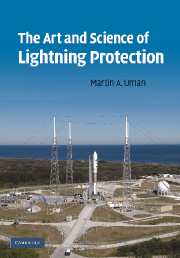Book contents
- Frontmatter
- Contents
- Preface
- 1 What is lightning?
- 2 Lightning damage
- 3 General methods for lightning protection: Faraday cages, topological shields; and more practical approaches: cone of protection and rolling sphere methods
- 4 Structure protection: air terminals and down conductors
- 5 Structure protection: grounding
- 6 Surge protection for electronics in low-voltage electrical systems
- 7 Humans and animals
- 8 Lightning warning
- 9 Airships, airplanes, and launch vehicles
- 10 Ships and boats
- 11 Trees
- 12 Overhead and underground power and communication lines
- 13 Lightning elimination
- 14 So, what do we know and what don't we know about lightning protection?
- Index
- References
14 - So, what do we know and what don't we know about lightning protection?
Published online by Cambridge University Press: 17 November 2009
- Frontmatter
- Contents
- Preface
- 1 What is lightning?
- 2 Lightning damage
- 3 General methods for lightning protection: Faraday cages, topological shields; and more practical approaches: cone of protection and rolling sphere methods
- 4 Structure protection: air terminals and down conductors
- 5 Structure protection: grounding
- 6 Surge protection for electronics in low-voltage electrical systems
- 7 Humans and animals
- 8 Lightning warning
- 9 Airships, airplanes, and launch vehicles
- 10 Ships and boats
- 11 Trees
- 12 Overhead and underground power and communication lines
- 13 Lightning elimination
- 14 So, what do we know and what don't we know about lightning protection?
- Index
- References
Summary
Does it work?
The most important thing we know about lightning protection is that if implemented in a manner consistent with existing standards, the protection will be successful most of the time. Many individual examples illustrate the value of lightning protection systems. Some are given below.
According to Schonland (1950):
The record of damage to churches, whose elevated steeples attract the lightning flash, is voluminous…. Perhaps the most famous of these structures is the Campanile of St. Mark in Venice which has had a very bad lightning history. It stands over 340 feet high in an area which, as already mentioned, experiences many thunderstorms. It was severely damaged by a stroke in 1388, at which time it was a wooden structure. In 1417 it was set on fire by lightning and destroyed. In 1489 it was again reduced to ashes. In 1548, 1565, and 1653 it was damaged more or less severely, and in 1745 a stroke of lightning practically ruined the whole tower. Repairs cost 8,000 ducats (3,000 pounds sterling in those days), but in 1761 and 1762 it was again severely damaged. In 1776 a Franklin rod was installed on it and no further trouble from lightning has occurred since.
We noted in Section 10.1 that William Snow Harris compiled a record of lightning damage to the unprotected wooden ships of the British Royal Navy.
- Type
- Chapter
- Information
- The Art and Science of Lightning Protection , pp. 232 - 235Publisher: Cambridge University PressPrint publication year: 2008



